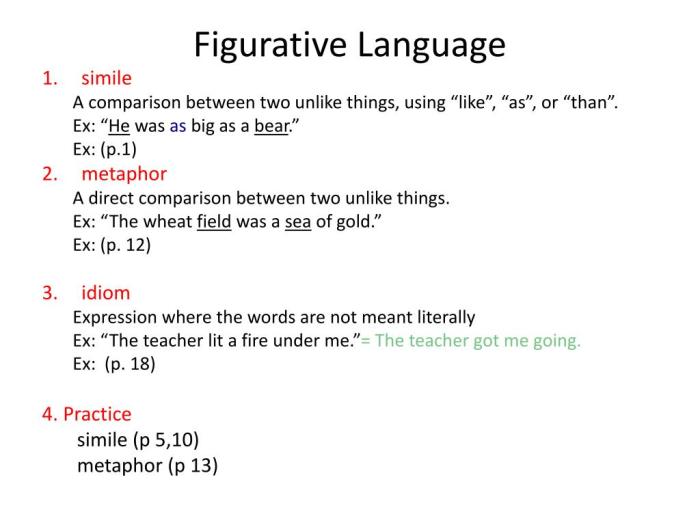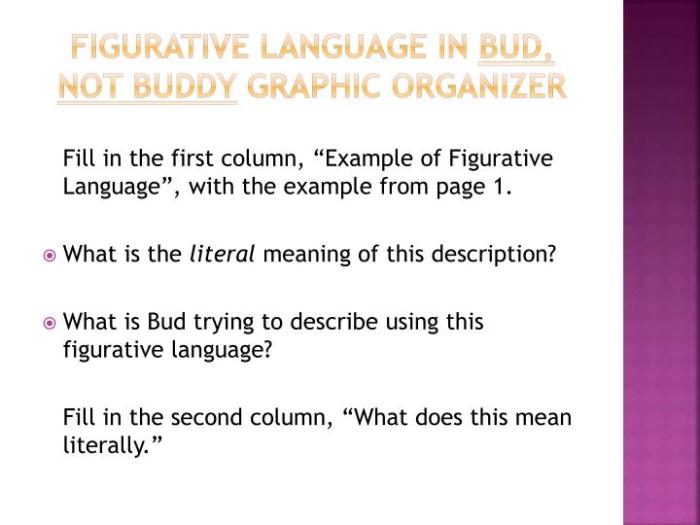Figurative language in bud not buddy – Figurative language in “Bud, Not Buddy” takes center stage, inviting readers into a world where language transcends its literal meaning. This literary analysis delves into the novel’s rich tapestry of metaphors, similes, personification, and other devices, illuminating their profound impact on the novel’s themes, characterization, and historical context.
Through an exploration of these literary techniques, we uncover the novel’s exploration of identity, racism, and the resilience of the human spirit during the Great Depression era.
Figurative Language in “Bud, Not Buddy”

The novel “Bud, Not Buddy” by Christopher Paul Curtis is a rich tapestry of literary devices, particularly figurative language. Curtis employs a variety of metaphors, similes, personification, and other devices to enhance the novel’s themes, characterization, and historical context.
Metaphors and Similes
Metaphors and similes are used extensively throughout the novel. For instance, the character of Bud is described as “a walking shadow” to convey his loneliness and isolation. Another metaphor compares the Great Depression to “a monster” that has “swallowed up” the dreams and hopes of many people.
Personification
Curtis also uses personification to bring inanimate objects and abstract concepts to life. For example, the train that Bud rides is described as “a hungry beast” that “roars” through the countryside. This personification adds a sense of danger and excitement to the journey.
Other Figurative Devices, Figurative language in bud not buddy
In addition to metaphors, similes, and personification, Curtis employs a range of other figurative devices, such as hyperbole, understatement, and irony. These devices help to create a vivid and memorable reading experience.
Thematic Exploration through Figurative Language

The use of figurative language in “Bud, Not Buddy” enhances the development and understanding of the novel’s major themes. For instance, the metaphor of the “monster” representing the Great Depression highlights the devastating impact of the economic crisis on individuals and families.
Furthermore, the personification of the train as a “hungry beast” symbolizes the relentless and unforgiving nature of poverty. These literary devices add depth and resonance to the novel’s themes, making them more accessible and impactful to readers.
Character Development and Figurative Language
Figurative language contributes significantly to the characterization of Bud. The similes and metaphors used to describe him reveal his inner thoughts and emotions. For example, the comparison of Bud to “a walking shadow” reflects his feelings of loneliness and isolation.
Additionally, the use of personification in Bud’s interactions with other characters adds depth and complexity to his relationships. For instance, the description of the train as a “hungry beast” highlights the danger and uncertainty that Bud faces on his journey.
Historical Context and Figurative Language

The historical setting of “Bud, Not Buddy” influences the use of figurative language in the novel. The Great Depression provides a backdrop of economic hardship and social upheaval, which is reflected in the metaphors and similes used throughout the story.
For example, the comparison of the Great Depression to a “monster” captures the devastating impact of the economic crisis on individuals and families. Additionally, the personification of the train as a “hungry beast” symbolizes the relentless and unforgiving nature of poverty.
Symbolism and Figurative Language: Figurative Language In Bud Not Buddy
Symbolic elements are present throughout “Bud, Not Buddy.” Figurative language enhances the symbolism of these elements, adding depth and resonance to the novel’s themes and characters.
For instance, the train in the novel symbolizes both hope and danger. This symbolism is reinforced through the use of metaphors and similes. The train is described as a “lifeline” and a “monster,” reflecting the dual nature of its role in Bud’s journey.
Key Questions Answered
What is the significance of figurative language in “Bud, Not Buddy”?
Figurative language enhances the novel’s themes, characterization, and historical context, providing a deeper understanding of the novel’s message and characters.
How does figurative language contribute to the characterization of Bud?
Similes and metaphors reveal Bud’s inner thoughts and emotions, while personification shapes his interactions with other characters.
What is the historical context of “Bud, Not Buddy” and how does it influence the use of figurative language?
The novel’s setting during the Great Depression influences the themes and characters, and figurative language adds depth and resonance to this historical context.

